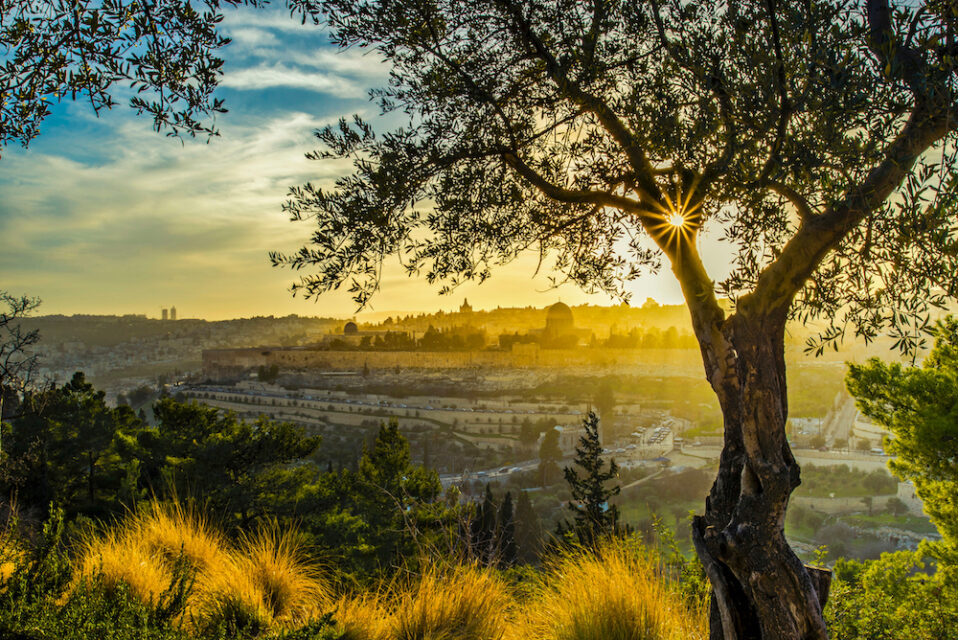By Marc Turnage
The Mount of Olives is a north-south ridge that sits on the eastern watershed of the hills around Jerusalem. To its east, the land slopes drastically down towards the Jordan River Valley and the area around Jericho, towards the Dead Sea.
The steep fall-off of the topography east of the Mount of Olives, together with the weather patterns coming from the west off the Mediterranean Sea, which causes the rain to fall along the heights of the hill country, means that the land to the east of the Mount of Olives sits in the rain shadow, with little vegetation. This wilderness provided refuge for those seeking concealment from the authorities. When David fled Jerusalem from Absalom (2 Samuel 15:13-23), he went over the Mount of Olives into this wilderness seeking refuge.
The Mount of Olives in antiquity never belonged inside the city of Jerusalem. It always sat as its eastern boundary separated from the city of Jerusalem by the Kidron Valley. The Mount of Olives also served as Jerusalem’s cemetery beginning in the Chalcolithic period (Stone Age). Tombs from the time of the Judean monarchy (Old Testament), as well as the first century (New Testament) have been discovered on the Mount of Olives. At the foot of the mountain sit three monumentally decorated tombs from the first centuries B.C. and A.D., one of which is the misnamed Tomb of Absalom.
When Jesus entered Jerusalem on His “Triumphal Entry” (Luke 19:28-29), He approached the city from the Mount of Olives. Pilgrims to Jerusalem today can walk down the Mount of Olives on the “Palm Sunday” processional route, but this would not have been the path Jesus took, as it led through a first century cemetery, which would have rendered Him ritually impure prohibiting Him from entering the Temple. Most likely His route would have taken Him over one the saddles of the ridge on either its northern or southern part.
The prophet Zechariah proclaimed that at the end of the age, when God’s kingdom is revealed in all the world, that He will stand on the Mount of Olives, which will split east to west, opening a chasm that will cause the mountain to move to the north and south (Zechariah 14:4). The Mount of Olives is not only connected to Jerusalem’s history in both the Old and New Testaments; it is also directly linked to its future.
Marc Turnage is President/CEO of Biblical Expeditions. He is an authority on ancient Judaism and Christian origins. He has published widely for both academic and popular audiences. His most recent book, Windows into the Bible, was named by Outreach Magazine as one of its top 100 Christian living resources. Marc is a widely sought-after speaker and a gifted teacher. He has been guiding groups to the lands of the Bible—Israel, Jordan, Egypt, Turkey, Greece, and Italy—for over twenty years.
Website: WITBUniversity.com
Facebook: @witbuniversity
Podcast: Windows into the Bible Podcast




Comments(3)-

-

-





Mary B Chambers says
March 21, 2023 at 7:57 pmI love Israel been to the mount of olive wonderful.
N yeatts says
March 23, 2023 at 9:50 pmLion of Judah soon coming King! Exciting
Guy Pierce says
March 23, 2023 at 11:21 pmI have read that when Jesus returns he will rule the entire world from the Mount of Olives.
Receive Devotionals and News Updates from Israel
Recent Posts
Chorazin: A Warning in the Ruins
Weekly Devotional: When Living Water Flows
Faith in Action: How American Christians Can Stand with Israel Today
American and Israeli Eagles in the Storms of Life